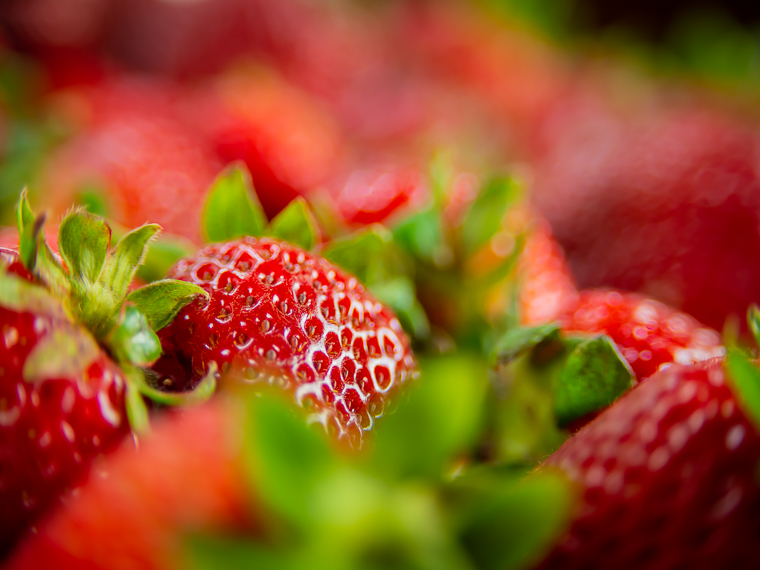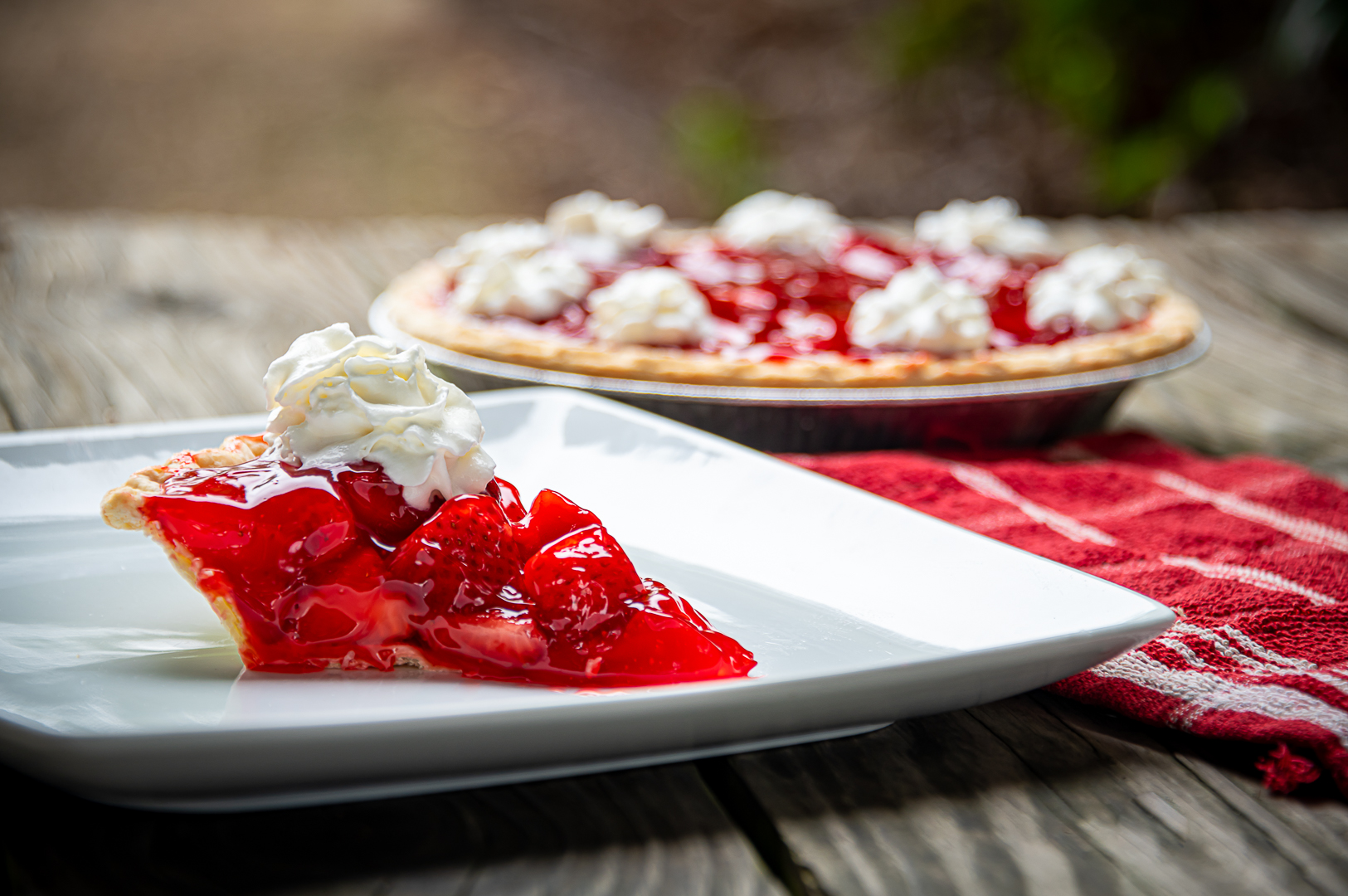The information presented on this page may be dated. It may refer to situations which have changed or people who are no longer affiliated with the university. It is archived as part of Mississippi State University's history.
PERHAPS AMONG ALL THE FRUITS, strawberries usher in the spring season, as local markets and grocers sell the juicy red berries in pints, quarts, and flats and as farms open after a long winter for consumers to pick the vine-ripened harvest. From the West Coast to the Deep South, this delectable fruit is one many wish never went out of season. That desire isn't too far out of reach, given that researchers in the Mississippi Agricultural and Forestry Experiment Station, or MAFES, are studying ways to extend the berry's growing season.
The scientists are using high tunnels, which though small in size, act as a greenhouse without the source of heating or cooling via mechanical means. They are metal frames covered with plastic, creating what is like a blanket over the crop. Temperatures are regulated by raising and lowering the sides of the tunnels or opening and closing doors to vent excess heat or capture it to warm the inside and accelerate growth.
High tunnels offer many advantages, though they are not a new invention. Dr. Richard Harkess, an ornamental horticulture professor in the Department of Plant and Soil Sciences, said the technology has been used around the world for some time.
"High tunnels are really an old technology we are just now more fully utilizing in the United States," Harkess said. "You see them used throughout Spain, Portugal, southern Europe, and throughout Asia. There is no limit to the technology, so it is applicable across most of the country."
Harkess added, "By creating a blanket over the crop, so to speak, you create an environment in the spring that warms up faster and allows the plants to grow and yield sooner," Harkess explained. "You can then extend the season in the fall, depending on the crop, by protecting them from frost and freezing temperatures. The three primary goals with any crop in a high tunnel are to avoid frost problems, provide crop protection, and extend the production season."
Dr. Tongyin Li, assistant professor, and Dr. Guihong Bi, research professor, both MAFES scientists in the Department of Plant and Soil Sciences, have been conducting research on growing strawberries in high tunnels for several years. The study took six June-bearing strawberry cultivars and two day-neutral cultivars and grew them in raised beds covered in either black or red plastic mulching film inside the high tunnel. The team was interested in off-season production with the help of high tunnels and how the color of mulch affected the development and quality of the berries. This initial research, which was the project of one of Li's graduate students, Geoffrey Lalk, wrapped up in 2018.
"The project was centered on off-season production of strawberries with the use of the tunnels and different colored mulch. It became evident that high tunnels give a significant advantage in terms of season extension, however, to my surprise, the plastic mulch color we tested did not affect strawberry plant vegetative growth nor fruit quality as much," Li said.
Bi added, "The high tunnel advanced strawberry harvest by four to six weeks in early spring with the first ripe fruit produced in early March," Bi said. "The high tunnel also offered exclusion from rain, reducing disease pressure and improvement in fruit quality.
The initial research created new ideas for the team.
In the fall of 2021, the team will begin experimenting with biodegradable mulch in a high tunnel production system to determine the effect on strawberry growth, yield, and quality, as well as the timing of fruit production.
"We want to select and identify a good cultivar suitable for local high tunnel production and evaluate how useful different biodegradable mulches are as sustainable alternatives," Li said. "Strawberry production relies heavily on beds covered with plastic, so we want to find alternative materials such as bioplastic or biodegradable mulch to be more sustainable, while still evaluating how early planting in high tunnels can increase production."
In strawberry production, plastic mulch is often used for weed control, soil moisture control, soil temperature increase, and improvement of crop yield and quality. When the plastic breaks down, it requires removal and creates waste. Biodegradable mulches have the capacity to decompose on their own, eliminating the need of removal and in turn minimizing negative environmental impacts, a key interest factor for Li.
"I am always interested in sustainable production of crops. For growers to go from conventional production to organic can be extreme, but it is always easier to adopt any practice that is more sustainable," Li added. "There are so many biodegradable products out there, and we want to look into how we can use these for improved sustainability."
The research, conducted at the MAFES R.R. Foil Plant Science Research Center, known as North Farm, will include eight to ten strawberry cultivars. Each cultivar will be planted with three to four different types of biodegradable mulches also being evaluated. With the use of high tunnels, raised beds inside the tunnels will be covered with the different mulch types, and the plants will be grown inside.
Li said that high tunnels offer producers new advantages.
"Strawberry is one of the most consumed fruits with many health benefits. There is an increasing consumer demand for locally produced fresh strawberries, and with Mississippi harvest from field production often starting in late April or early May, growers now have the potential to gain an edge on the markets by having their berries ripen a month or more early," Li said.
While not all producers may benefit from implementing high tunnels into their methods, local growers in areas where strawberries are not a major commercial product can increase their income by incorporating this method. Allowing for more local producers also betters the local market and supply of strawberries.
"It is all about timing. Any time you can bring a product in at a time when you cannot go out in the garden and pick it, it is going to increase its value," Harkess said. "Using a high tunnel allows for production to be brought in earlier, increasing local production for local markets. If you can produce a crop locally that is fresher when it hits the shelf, the shelf life is, in turn, longer."
He continued, "Out of season, there is not the local production to satisfy the local market. But high tunnels add the capability of getting the crop into production and yielding earlier so that we can satisfy local markets with local produce."
With the help of MAFES scientists, there is hope that the sweetness of strawberries can endure beyond the season we've come to expect, yielding fruit longer.
This research was funded by a MAFES Special Research Initiative. Future research is funded by the Specialty Crop Block Grant Program through the USDA.
I am always interested in sustainable production of crops...There are so many biodegradable products out there, and we want to look into how we can use these for improved sustainability.
Dr. Tongyin Li


